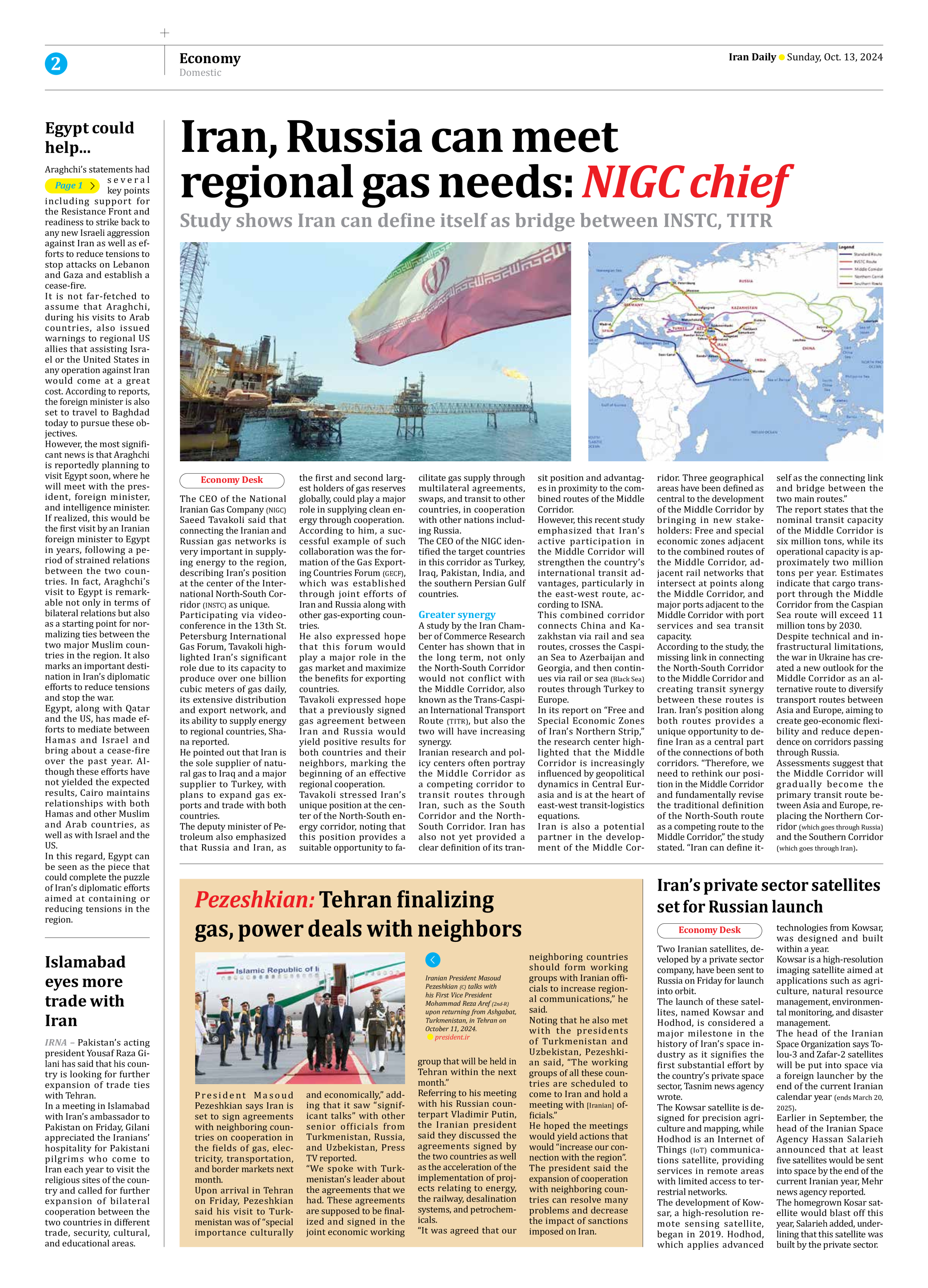
Iran, Russia can meet regional gas needs: NIGC chief
Study shows Iran can define itself as bridge between INSTC, TITR
The CEO of the National Iranian Gas Company (NIGC) Saeed Tavakoli said that connecting the Iranian and Russian gas networks is very important in supplying energy to the region, describing Iran’s position at the center of the International North-South Corridor (INSTC) as unique.
Participating via videoconference in the 13th St. Petersburg International Gas Forum, Tavakoli highlighted Iran’s significant role due to its capacity to produce over one billion cubic meters of gas daily, its extensive distribution and export network, and its ability to supply energy to regional countries, Shana reported.
He pointed out that Iran is the sole supplier of natural gas to Iraq and a major supplier to Turkey, with plans to expand gas exports and trade with both countries.
The deputy minister of Petroleum also emphasized that Russia and Iran, as the first and second largest holders of gas reserves globally, could play a major role in supplying clean energy through cooperation.
According to him, a successful example of such collaboration was the formation of the Gas Exporting Countries Forum (GECF), which was established through joint efforts of Iran and Russia along with other gas-exporting countries.
He also expressed hope that this forum would play a major role in the gas market and maximize the benefits for exporting countries.
Tavakoli expressed hope that a previously signed gas agreement between Iran and Russia would yield positive results for both countries and their neighbors, marking the beginning of an effective regional cooperation.
Tavakoli stressed Iran’s unique position at the center of the North-South energy corridor, noting that this position provides a suitable opportunity to facilitate gas supply through multilateral agreements, swaps, and transit to other countries, in cooperation with other nations including Russia.
The CEO of the NIGC identified the target countries in this corridor as Turkey, Iraq, Pakistan, India, and the southern Persian Gulf countries.
Greater synergy
A study by the Iran Chamber of Commerce Research Center has shown that in the long term, not only the North-South Corridor would not conflict with the Middle Corridor, also known as the Trans-Caspian International Transport Route (TITR), but also the two will have increasing synergy.
Iranian research and policy centers often portray the Middle Corridor as a competing corridor to transit routes through Iran, such as the South Corridor and the North-South Corridor. Iran has also not yet provided a clear definition of its transit position and advantages in proximity to the combined routes of the Middle Corridor.
However, this recent study emphasized that Iran’s active participation in the Middle Corridor will strengthen the country’s international transit advantages, particularly in the east-west route, according to ISNA.
This combined corridor connects China and Kazakhstan via rail and sea routes, crosses the Caspian Sea to Azerbaijan and Georgia, and then continues via rail or sea (Black Sea) routes through Turkey to Europe.
In its report on “Free and Special Economic Zones of Iran’s Northern Strip,” the research center highlighted that the Middle Corridor is increasingly influenced by geopolitical dynamics in Central Eurasia and is at the heart of east-west transit-logistics equations.
Iran is also a potential partner in the development of the Middle Corridor. Three geographical areas have been defined as central to the development of the Middle Corridor by bringing in new stakeholders: Free and special economic zones adjacent to the combined routes of the Middle Corridor, adjacent rail networks that intersect at points along the Middle Corridor, and major ports adjacent to the Middle Corridor with port services and sea transit capacity.
According to the study, the missing link in connecting the North-South Corridor to the Middle Corridor and creating transit synergy between these routes is Iran. Iran’s position along both routes provides a unique opportunity to define Iran as a central part of the connections of both corridors. “Therefore, we need to rethink our position in the Middle Corridor and fundamentally revise the traditional definition of the North-South route as a competing route to the Middle Corridor,” the study stated. “Iran can define itself as the connecting link and bridge between the two main routes.”
The report states that the nominal transit capacity of the Middle Corridor is six million tons, while its operational capacity is approximately two million tons per year. Estimates indicate that cargo transport through the Middle Corridor from the Caspian Sea route will exceed 11 million tons by 2030.
Despite technical and infrastructural limitations, the war in Ukraine has created a new outlook for the Middle Corridor as an alternative route to diversify transport routes between Asia and Europe, aiming to create geo-economic flexibility and reduce dependence on corridors passing through Russia.
Assessments suggest that the Middle Corridor will gradually become the primary transit route between Asia and Europe, replacing the Northern Corridor (which goes through Russia) and the Southern Corridor (which goes through Iran).







